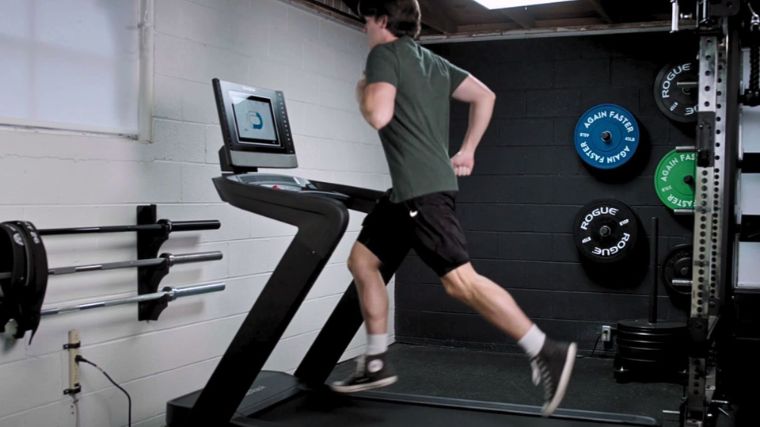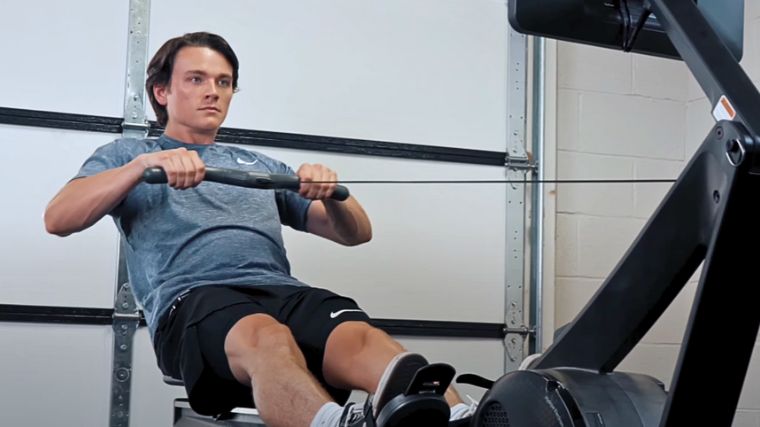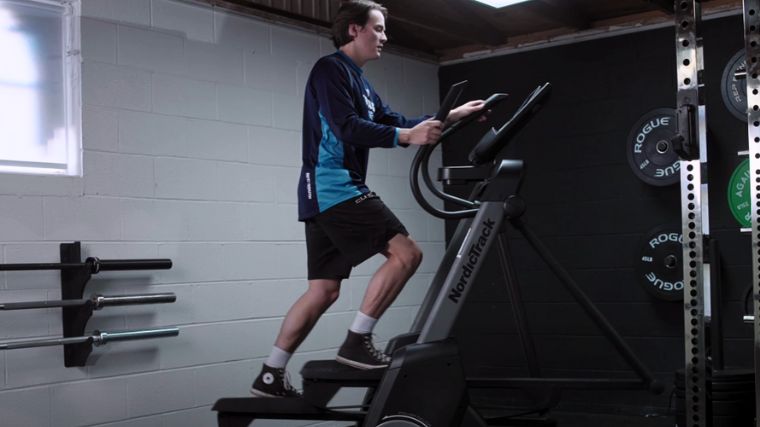Of the many myths that populate the world of fitness, the notion that cardio exercise directly burns body fat might be the most pervasive of them all. A whole host of infomercials and influencers have promoted this “cardio as a fat-burning cure-all” prescription. In the end, many gymgoers have developed mistaken beliefs about cardio and motivations for hitting the treadmill.
By taking the time to fully understand what cardio can and can’t do to promote fat loss, you can build a more efficient plan to reduce body fat and optimize your cardio workouts. Here’s what you need to know, right from the mouth of one of our finest experts.

Editor’s Note: The content on BarBend is meant to be informative in nature, but it should not be taken as medical advice. When starting a new training regimen and/or diet, it is always a good idea to consult with a trusted medical professional. We are not a medical resource. The opinions and articles on this site are not intended for use as diagnosis, prevention, and/or treatment of health problems. They are not substitutes for consulting a qualified medical professional.
What Is Cardio?
In the context of treadmill workouts and sprint sessions, “cardio” is short for “cardiovascular exercise.” It refers to a form of exercise that increases your heart rate and maintains it at an elevated pace for an extended period.
Alternate definitions of cardio may include having your largest muscle groups involved in the exercise, since the movement of these muscles is often necessary to sustain an elevated heart rate. Think: running, box jumps, and using a rowing machine.
In practice, cardio workouts often take the form of low- to moderate-intensity physical activity intended to move the body from one place to another. These types of exercises might range from walking and running to swimming, skiing, rowing, cycling, or even steady mountain climbing.
Does Cardio Actually Burn Fat?
Cardio does not literally target and burn body fat. This is because the systems that enable you to burn fat are as complex as the processes that form fat in the first place.
What Is the Relationship Between Cardio and Fat Loss?
The correlation between the exercises you perform and the body weight you lose depends on how much energy you use relative to how much energy you consume — i.e., your caloric intake. This is essential to understand because only a fraction of your weight loss will be the result of intentional physical activity. And, not all of the weight you lose will consist of body fat.
How Does Your Body Lose Fat?
Calories are a unit of energy, much like centimeters or inches are units of distance. At the most basic level, body fat is stored when the number of calories you consume exceeds the number of calories you burn. (1)
If the amount of calories you ingest exceeds your daily energy expenditure, your body stores the excess calories as fat. The amount of energy you need each day includes your basal metabolic rate (BMR), which is how much energy your body needs to maintain its most basic functions.

[Read More: Best Fat Burners]
By storing excess calories as fat, your body is ensuring that you’ll have energy later if needed. If you eat too few calories to function, your body may burn fat to make up the shortfall.
How Cardio Influences Weight Loss
Simply stated, your body burns calories to fuel your fitness activities. The intensity and duration of your cardio session will determine the total number of calories burned while you train. (2)
For instance, lower-intensity cardio burns fewer calories than faster-paced cardio. That’s because 10 minutes of jogging takes less energy than, say, 10 minutes of hard running.
Still, the amount of energy (calories) that exercise uses compared to the amount of energy your body needs for its most basic functions is pretty small. Exercise will usually burn only a small fraction of calories compared to your BMR, so a calorie deficit is most easily created through your nutrition plan.
How to Add Cardio to Your Training
The form of cardio you decide to add to your training depends on several personal factors. If you are just getting started on your path to fitness, an exercise like brisk walking on a cushioned treadmill may be the most accessible path.
On the other hand, if you’re more experienced and aiming to up the ante, high-intensity interval training (HIIT) may be the way to go. HIIT treadmill workouts or other forms of HIIT might be more attractive to someone wanting to bring the heat.
This approach might be extra enticing if you’re aiming to build muscle mass. HIIT can provide physiological outcomes similar to more traditional, low-intensity cardio in a shorter amount of time. (3)

[Read More: The Best Foods for Energy Before, During, and After Your Workouts]
It’s not all about running, either. Here are some options for adding cardio to your routine:
- Low-intensity steady-state (LISS) cardio, including walking your dog, jogging, and low-intensity sessions on the elliptical or exercise bike
- Rowing machine workouts
- Sprint workouts
- CrossFit-style workouts featuring moves like box jumps, burpees, and barbell thrusters
Regardless of the form you select, cardio can improve your heart health along with, yes, burning calories. (4)
If you opt to use cardio to boost your caloric deficit, cardio routines can be added before or after your strength training sessions, or they can serve as their own standalone workouts.
Note: if your main goal is building strength, you’ll want to perform your cardio training after strength training. If your main goal is building a strong cardio base, you can do cardio first.
Other Cardio Misconceptions
The belief that consistent cardio is the biggest key to weight loss is just the tip of the iceberg. The more you unpack this misunderstanding of what cardio can accomplish, the more you’ll expose the smaller myths about cardio that prop up the larger misconception.
This is why it’s nice to have access to expert-level guidance to help explain away the myths — and that’s exactly what we have for you.
Misconception #1: All of the calories you burn during cardio come directly from fat.
You may have heard that a pound of fat equals 3,500 calories. You may also have been led to believe that every calorie burned during exercise chips away at a specific pound of fat on your body. Sadly, this is a major oversimplification of the energy-production process.
“Your body generates energy from a variety of different sources and systems to power exercise and movement,” says Dickson. “While body fat stores are a preferred fuel source, your body can only oxidize so much fat at a time. It’s more practical to keep track of caloric expenditure and not worry so much about what energy source your body is turning to at the moment.”
Misconception #2: Unless your heart rate is in its fat-burning zone, you won’t burn fat while you exercise.
A well-intentioned personal trainer might have told you that aerobic exercise was essential for fat-burning, and then directed you to the area of a fancy chart labeled “fat-burning zone.” While there is a kernel of scientific truth behind that general premise, don’t allow it to steer you away from higher-intensity methods like HIIT workouts.
[Read More: Best Fat Burners for Men]
“While there is technically a range of energy expenditure wherein body fat is the ‘preferred’ fuel source, understand that you don’t necessarily lose fat during your workout,” explains Dickson. “Your body is constantly adjusting its total energy balance (like a financial spreadsheet or checkbook). The calories you burn during your workout will result in fat loss if, at the end of the day, you’ve burned more energy than you’ve consumed from food. This is called a negative net energy balance.”
Misconception #3: Cardio is always better than strength training for burning fat.
You know that weight training helps build muscle. But cardio is not the only exercise that contributes to fat loss. Not only does this approach impose a very narrow view of wellness, but it also overlooks the role that strength training plays in promoting fat loss.
[Read More: Everything You Need to Know About How to Increase Strength]
“It’s not productive to view exercise through a qualitative lens when trying to lose fat,” says Dickson. “One type of workout may burn more calories than another, but the type of training you choose to perform will provide a host of unique benefits. For instance, a moderately difficult strength training workout may burn fewer calories than an hour on the stair-stepper, but lifting weights also strengthens your muscles, improves bone density, and can even increase your overall metabolic rate by building new muscle tissue.”
How to Lose Weight
- Alter your daily calorie intake with a healthy diet: Limiting your calories to a sustainable but in-deficit range will make it easier to create the type of caloric deficit that results in fat loss.
- Build muscle mass with resistance training: By taking steps to grow new lean muscle mass, you will increase the amount of metabolically active tissue in your body, enabling you to burn more calories at rest.
- Increase the amount of time you devote to cardiovascular exercise: Consistent cardio training can expedite your body’s energy utilization and slightly broaden your daily caloric deficit. It’s important to note that this is far from the first thing that should be on your list — instead, cardio can be considered a supplementary tool in your box.
For a measure of how many calories you should eat per day if you’re aiming to lose weight, check out BarBend’s calorie calculator. Remember that the key to safer, more sustainable weight loss is making sure you have enough energy to fuel your daily activities and enjoyment.
Calorie Calculator
[Read More: How to Calculate Your Macronutrients for Weight Loss]
Your Takeaways
So can cardio burn fat? Here’s what you should be walking away with.
- While cardio does not directly burn your belly fat, it can be one component of a multifaceted strategy to alter your body composition.
- There are many different kinds of cardio you can integrate into a balanced training program.
- Calories are a unit of measuring energy. The calories you burn — the energy you use — during cardio does not necessarily come from fat. And that’s OK.
- Your heart rate does not have to be in the “fat-burning zone” for cardio to be effective.
- Strength training can be a significant driver of body recomposition.
- The amount of energy (calories) you need to maintain your body’s basic functions is much greater than the energy (calories) you burn in a cardio workout during any given day. Cardio is only a small component of any overall weight loss goal.
FAQs
Still looking for answers about whether or not cardio should be your go-to tool for fat-burning? Here are some quick answers to help you along!
What cardio is best for fat loss?
For most people, cardio alone is not a reliable strategy for fat loss; caloric deficit is a more significant factor. Studies demonstrate that physical exercise alone is unlikely to result in significant weight loss unless the exercise is of an exceedingly high (and possibly dangerous) volume. (5)
Why do they say cardio doesn’t burn fat?
For most people, cardio does not directly burn fat in a meaningful, sustainable, or predictable sense. This is because the relationship between cardio and fat burning is not direct.
Cardio’s foremost contribution to eliminating fat is its ability to increase the number of calories you burn in a day. This forces your body to break down stored fat to compensate for energy shortfalls. Still, the amount of calories you use during a cardio session pales in comparison to the amount of energy your body needs to fuel its basic activities and functions.
How long should I do cardio to burn fat?
HIIT workouts are short (less than 20 to 30 minutes), while low-intensity steady-state cardio sessions may last over a half hour. The best cardio exercise and length is one that you enjoy and will consistently do over time.
You might strive to do at least 20 minutes of cardiovascular exercise each day, but that might have more heart health benefits than impacts on your waistline. The net results of consistent strength training may contribute more to the burning of body fat than cardiovascular exercise.
References
- Redinger RN. Fat storage and the biology of energy expenditure. Transl Res. 2009 Aug;154(2):52-60.
- Marandi SM, Abadi NG, Esfarjani F, Mojtahedi H, Ghasemi G. Effects of intensity of aerobics on body composition and blood lipid profile in obese/overweight females. Int J Prev Med. 2013 Apr;4(Suppl 1):S118-25.
- Atakan MM, Li Y, Koşar ŞN, Turnagöl HH, Yan X. Evidence-Based Effects of High-Intensity Interval Training on Exercise Capacity and Health: A Review with Historical Perspective. Int J Environ Res Public Health. 2021 Jul 5;18(13):7201.
- Nystoriak MA, Bhatnagar A. Cardiovascular Effects and Benefits of Exercise. Front Cardiovasc Med. 2018 Sep 28;5:135.
- Swift DL, Johannsen NM, Lavie CJ, Earnest CP, Church TS. The role of exercise and physical activity in weight loss and maintenance. Prog Cardiovasc Dis. 2014 Jan-Feb;56(4):441-7.